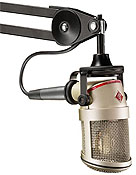|
Neumann
BCM 104 Broadcast Microphone |
|

Product Code:
BCM104


|
Emotion conveyed with technical
perfection. This is the ideal which the Neumann microphones in the Broadcast
Line have been designed to fulfill. The fine-tuning to the requirements of
professional broadcast studios and the individual, functionally optimized
design* ensure that these are microphones of character.
With its large-diaphragm condenser capsule and cardioid directional
characteristic, the BCM 104 is ideal for the faithful reproduction of speech and
music. This is due, for instance, to the frequency response that is flat up to 3
kHz and then gradually boosted in the higher frequencies. If required, internal
switches can be used to compensate for the proximity effect and to reduce the
sensitivity by 14 dB. The versatility of the BCM 104 can be seen in its wide
range of applications, from news, to round-table discussions, to radio plays, to
musical recordings.
Mechanical Features
The microphone headgrille twists off easily for quick cleaning. Neumann offers
optional color-coded headgrilles so that, for reasons of hygiene, each announcer
can use his or her individual headgrille. In front of the capsule, mounted on a
frame holder, a fine gauze serves as a built-in popscreen.
The microphones of the Broadcast Line have an elastic mount against
structure-borne noise, that is compatible with standard broadcast-segment
microphone arms.
Acoustic features
The microphone headgrille houses the K 04 large-diaphragm capsule, which has a
flat frequency response up to 3 kHz. Higher frequencies have an increased
presence up to 2 dB.
Since the above-mentioned microphone characteristics are obtained without the
use of resonance effects, the microphone features excellent transient response
and transmits all transient phenomena of music and speech without any
coloration.
The integrated Pop Screen
A pop screen not only prevents the occurrence of plosive pop noises in vocal
recordings, but also efficiently prevents unwanted particles, from respiratory
moisture, nicotine, to food remnants, from settling on the diaphragm. The pop
screen can be removed for cleaning without the use of tools.
Electrical features
Instead of a transformer to couple the microphone output to the supply voltage,
the BCM 104 has an electronic circuit which, like a transformer, provides for
good common mode rejection.
Interference induced in the balanced modulation line is thus suppressed
effectively.
With a very low self-noise of 7 dB(A), and an overload capability extending to
138 dB SPL, the BCM 104 has a dynamic range of 131 dB (A-weighted).
Filter and Preattenuation
The BCM 104 amplifier has a linear operation down to 20 Hz. An active filter
efficiently suppresses signals below this frequency. In order to compensate for
the proximity effect, an electronic high-pass filter, activated by a switch, is
built into the microphone. This filter reduces frequencies below 100 Hz by 12
dB/octave.
A 14-dB preattenuation switch is provided in order to adjust the sensitivity, if
necessary, to circuits designed for dynamic microphones. But this will increase
the self noise accordingly.
Both switches are located inside the microphone housing, since they will
normally be operated only once, when the broadcasting facility is set up.
Mounting
The preferred mode of operation is to suspend the BCM 104 or BCM 705 from a
standard studio boom arm.
A thread adapter to fit different connector threads is included. In order to
provide protection from structure-borne noise, both the capsule and the
microphone in its mount are elastically suspended.
The optional SG 5 swivel mount allows additional angling of the microphone by
+/-90 degrees. |
� Large-diaphragm condenser capsule
� Cardioid directional characteristic
� Characteristic, functionally optimized design*
� Integrated pop protection
� Integrated elastic suspension
� Individual headgrilles for different users
� Colored rings to identify the replacement headgrilles
� Easy removal and cleaning of microphone headgrille (with bayonet mount)
� Mechanical compatibility with standard studio boom arms
� Internal switches: high-pass and pre-attenuation |
| Acoustical operating
principle |
Pressure gradient transducer |
| Directional pattern |
Cardioid |
| Frequency range |
20 Hz ... 20 kHz |
| Sensitivity at 1 kHz into 1
kohm |
22 mV/Pa |
| Sensitivity at –14 dB
attenuation |
4.4 mV/Pa |
| Rated impedance |
50 ohms |
| Rated load impedance |
1 kohms |
| Equivalent noise level,
CCIR1) |
18 dB |
| Equivalent noise level,
A-weighted1) |
7 dB-A |
| Maximum SPL for THD 0.5%2) |
138 dB |
| Maximum SPL for THD 0.5% with
preattenuation2) |
152 dB |
| Signal-to-noise ratio, CCIR1) (rel. 94 dB
SPL) |
76 dB |
| Signal-to-noise ratio, A-weighted1) (rel. 94
dB SPL) |
87 dB |
| Maximum output voltage |
10 dBu |
| Dynamic range of the microphone amplifier
(A-weighted) |
131 dB |
| Supply voltage (P48, IEC
61938) |
48 V ± 4 V |
| Current consumption (P48, IEC
61938) |
3.2 mA |
| Matching connector |
XLR3F |
| Weight |
500 g |
| Diameter |
64 mm |
| Length |
85 mm |
| Height (without suspension) |
110 mm |
|
|
|
|
|
|
| |
|
|